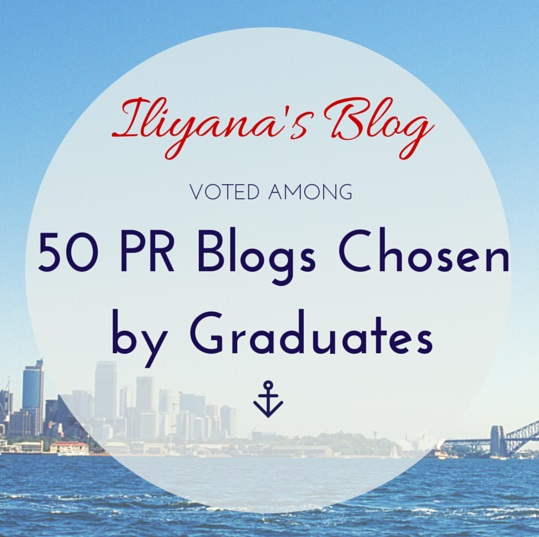Do you agree: storytelling is  THE buzzword of the year in marketing and communications? From what I've seen, and read, and experienced, it sure is. I also got addicted (and still am) to studying storytelling and learning how to use it as a powerful tool in PR and social media (see here, here, here and here).
THE buzzword of the year in marketing and communications? From what I've seen, and read, and experienced, it sure is. I also got addicted (and still am) to studying storytelling and learning how to use it as a powerful tool in PR and social media (see here, here, here and here).
Apparently, the hype hasn't just affected me, but the whole profession seems to be fascinated with storytelling for business.
This was more than evident at the dmexco in Cologne last week – the international digital marketing exposition and conference with the motto "connecting the global digital economy".
I was at the #dmexco on the second day and even though I got to choose which seminars and sessions to visit, many of them touched upon or were entirely focused on the importance of brand storytelling.
But why this sudden fascination? Why this massive interest?
Big shift in media
Well, one of the reasons, obviously, is the "big shift in media" that we've observed over the last decade or so.
This shift is what Jonah Peretti, CEO of BuzzFeed, presented in a really cool and funny way at the closing keynote at the event.
When talking about the "evolution" of BuzzFeed, he said that the company has quickly grown to an organisation which has the reach of a traditional media company, but doesn't function as one. This has been due to the emergence of thousands of new media technologies and types, which on the other hand have transformed media consumption and information sharing.
Today, attention has shifted – your audience is on social and mobile, not TV or radio.
So, the learning here is this: be where your consumers are and be relevant.
The very essence of BuzzFeed revolves around the notion of "making something worth sharing and passing along" – completely contradicting the old thinking of advertising and pushing top-down messages, which doesn't work anymore. Why? Because that's not what people want. Today:
- they want something that is inspiring and comforting – content that helps them remember that people do good; they want content that makes them say "Wow, I really needed this today" and then pass it along to a friend who they think might need it too;
- they want to see pics and videos of animals (funny, right?) because they are actually about strengthening the human connection, it brings about emotion and memories;
- they want quizzes that challenge their thinking or simply make them laugh;
- they want identity content or basically relevant first-hand experience that others have also had, something that fits their lifestyles too.
Organisations then need to open their eyes and see that the value of word of mouth (or earned media) is much higher than simple paid ads. They need to understand the spirit of the internet and the evolving way of consuming media. Brands need to learn to speak the language of the web.
Speak the language of the web
Obviously, that's easier said than done.
As Damian Burns, Director of Global Strategic Partnerships at Google, said, most organisations are still using the models of yesterday, trying to do the job of today. But that's not how you do high-value work. Ask yourself: Where is it that silos can be collapsed?
David Shing from AOL talked about how consumer habits have changed and how everyone now creates and curates content. Personal expression has so become the new form of entertainment. FOMO – Fear of Missing Out – is prevalent.
Today, it's all about connecting humans. With the rise of digital and the constantly emerging new platforms, brands have so many ways to capture hearts and minds. Digital really is the only place where you can have direct conversations with humans – you can't have such direct intimacy over TV, radio or print nor can you personalise and customise your messaging so individually.
But brands need to be remarkable.
So, how do you move from innovation to invention, how do you disrupt markets and categories and channels? How to you connect with the connected generation? You get back to building stuff.
People want to be at the centre of their experiences – brands need to put 'you' (not celebrities) at the centre. Why? Well, we live in an attention economy that's quickly becoming a collaboration economy, where people want to make an impact.
We want access over ownership.
The world of sharing of EVERYTHING
And what's easier to share than a memorable story? Well, nothing.
So, why is it that we need such stories?
In his talk "From storytelling to storylistening", Dietmar Dahmen spoke about how our world has become hyper connected and saturated; consumers have become more demanding, more smart, more knowing. Information is everywhere. The advantage as a market leader is quickly shrinking because every product can be easily and quickly copied.
What he said too is that a brand has no physical objectivity. Now, what companies have to do is sell a way of life.
Because you don't buy a bike, you buy the dream and the story around the bike.
The asset of your brand is the dream, the service, and it's in your head. The brand exists in the heart and soul of the customer.
Those are all stories, stories that spread value, stories that are relevant, stories that tell you "I'm about to change your future".
And here's where the power of storylistening comes into play.
To develop such stories brands need to have sensors to help them identify what is it that can make a difference in people's lives, what is it that adds value. They need to sense what matters to consumers and detect different situations to address these sensations appropriately. You can't speak to someone at a rock concert using totally formal language, and you can't talk to someone in slang at the opera.
So, brands need to detect the context to enable them to define what the story is about.
Technology has broken down ALL communications silos
Today, detecting emotions is pretty easy because we are emotionally connected with our devices. Check out the necomimi for example – those are brainwave cat ears that detect brain activity. Our phones have 15 sensors to listen too. And what about Google Glass? It has sensors to detect body motions such as breathing, or it has fitness tracking, alertness and stress management tools that are highly personalised to you, knowing everything about you and your interests wherever you go. These devices know if you lie – for example, you might say to a friend "I worked out today", but your device knows "No, you didn't!".
We live in a world of full transparency of emotions, actions and desires. So, as a brand you need to make use of that BIG DATA and match it to your story and your service. Detecting context with smart analytics really is the trick.
Face to face becomes interface to interface
To do so, you need to be open because relevance comes from many sources – friends, colleagues, media, content...
The where, the when and the who all determine relevancy. So, stories depend on where and when they're told as well as on who's telling them.
As Dietmar explains, there are no mobile channels, there are situations because everything is multi-screen now. The fight for attention is BIG. There are millions of conversations happening. Unlike old traditional marketing where we used to have high reach, but low relevance, today we have low reach, but huge relevance if we succeed.
Less like a book, more like a letter
The key to storytelling, Dietmar says, is having one big message. The example he gives is "I'm lovin' it", which I think is pretty self-explanatory.
Another very important thing is individualisation.
"Tell me what I want, give me what I need" – this is how today's consumer is – very individual, very me.
According to Dietmar, this turns marketing into narcissist marketing and content creation and drives a requirement for narcissism of products and services. However, having a single view of the customer over the whole lifecycle (online, mobile, offline at a café etc.), i.e. highly individualised, and knowing exactly when and where to reach her, brings 400% more profit.
So you have to be in the flow zone. You have to storylisten now.
Making next NOW
Jodie Stranger and Stefan Uhl from Starcom MediaVest Group started their seminar "From Storytelling to Storybuilding", explaining how people today don't care, they just do what they like and what they want.
This is making brands reconsider their traditional very linear business and communications models because the requirement of the modern world is a collaborative, non-liner, it-happens-now culture.
However, this conversion of media, technology and data is more of an opportunity that allows us to build stories in new ways.
Technology and infrastructure make it possible to storylisten and so capture and share content and human experiences in real time.
This means that brands need to be part of the live conversations that are happening now and they need to build stories together with consumers.
Storybuilding at the speed of culture
Jodie and Stephan identified five rules for co-creation that brands should follow to move away from storytelling to storybuilding:
- Visuals take center stage
The way consumers want to engage has changed. They require visuals. They have a new outlook for self-expression, allowing them to lean in for themselves.
This new phenomenon, largely driven by millennials, has now a name: TL;DR – too long, didn't read.
- Freedom to play together
Brands should become more innovative with their campaigns and start including people in them. They need to invite consumers to do things together and make ordinary people the heroes of the stories. That's how you can capitalise on the power of authenticity via user-generated content (UGC). One good example of involving people is Heineken's #ShareTheSofa campaign.
- Everything is a canvas
With all the new cool visual tools and apps out there – think about the massive growth of Instagram – people are tapping into their own creativity by playing around and creating all these beautiful images, many of which look highly professional.
The online space is filled up with amazing individual creations. These are not just "sitting" on the personal channels, but they spread everywhere.
Consumers are taking brand platforms and are making them their own. Just think about the #ShareaCoke with the McGillicuddys that went crazy viral (over 4 million views on YouTube!) and wasn't brand content.
- You are what you share
Why is it that you share something? Is it because you liked something or because you were moved by it, or is it because you hated it and you found it terrible?
Whichever it is, both make a statement. Whatever the reason for sharing, it explains a lot about who you are.
What brands need to know here is that there are three main themes that get shared:
- humour – people want to laugh (there's nothing like a funny cat video to make your day more cheerful)
- cause – people want to feel like part of something bigger and do good (think about P&Gs #LikeAGirl)
- inspiration – people want to achieve something (here's where all the before and after and how-to stories come into play)
- There is no time like live
Conversations are happening every second. Brands can't lack behind because consumers don't have the patience or desire to wait.
What's more, the old linear messaging is dead. Answers don't start relationships. Asking questions starts conversations, telling something ends conversations.
Real-time two-way participation is key to capitalise and act on what's happening in the social space. Because Return On Engagement is powerful.
Two great examples here that were newsjacking on big events were Oreo's Super Bowl tweet and the Oscar's selfie – both completely in the moment. Such immediacy makes what modern storybuilding should look like.
As you can see, the day at the dmexco was indeed very inspiring and thought-provoking. I would also say that, in all seminars and speeches I attended, there were some very apparent common themes, mainly dealing with the need for emotional, unique stories in business.
Agility, real-time immediacy, always-on sensors, 100%-now individual centricity and hyper visual content seem to be the major aspects, the next big things that determine how we will build brands in the digital age.
What do you think the next big things will be?






